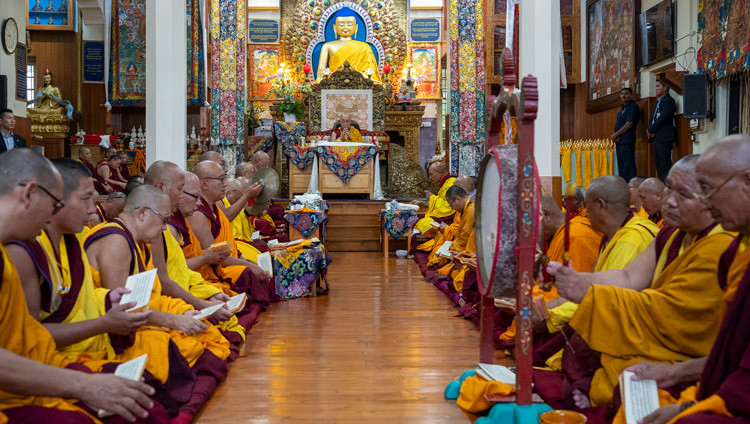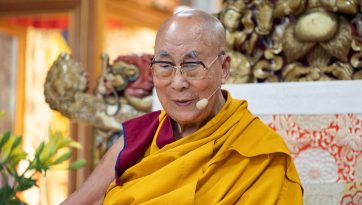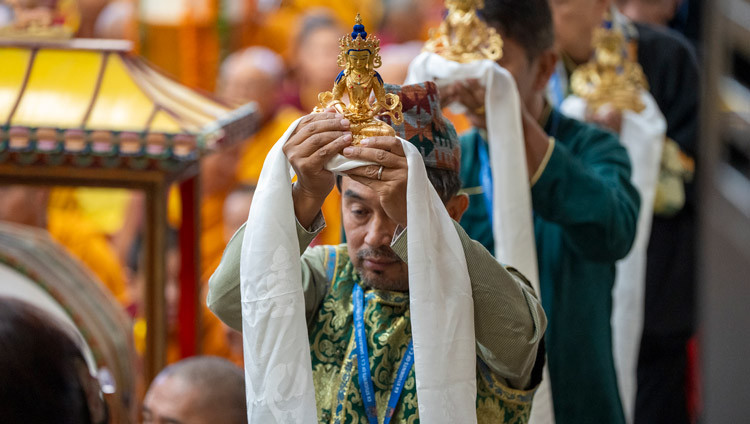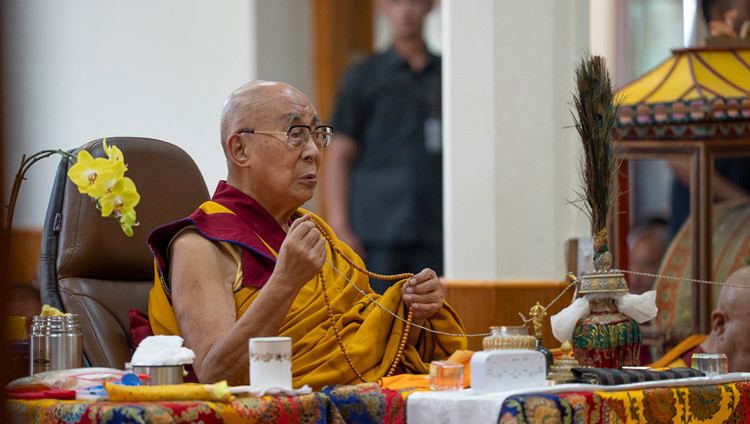Meeting with Baltic States Parliamentarians & Continuation of Teachings
September 25, 2017
Veteran Tibet supporter and Latvian MP Andris Buikis reminded His Holiness that the Baltic States were occupied for 50 years, so he and his colleagues understand and sympathise with what the people of Tibet are going through. He told him there are various Parliamentary Friendship Groups in Latvia, but the two he is primarily interested in concern Tibet and Taiwan. He added, “We are happy to provide an opportunity for people who can’t otherwise meet you to do so.”
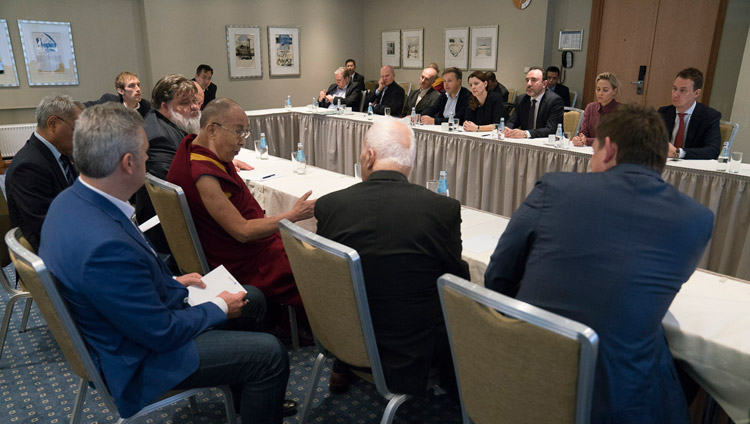
“I escaped from Tibet in 1959 after our various efforts to find a peaceful solution had failed,” His Holiness responded. “I reached India, where I have lived for the last 58 years as a stateless refugee. However, I also gained access to the global community. When I made my first visit to Europe in 1973 I told BBC correspondent Mark Tully I was going because I was a citizen of the world. In 1979, I went to the Soviet Union where I had a clear impression of people living in fear of attack from the West. At the same time I knew that people in the West lived in fear of an attack from the Warsaw Pact.
“Totalitarian systems don’t last forever and when the Soviet Union collapsed you here in the Baltic States seized the opportunity to restore your independence. President Landsbergis invited me to Lithuania.
“It’s an honour for me to meet with you parliamentarians again. I believe that sometimes smaller nations which are no threat to China can be more critical in what they tell them.
“We approached the UN in 1959, 1962 and 1965, but Nehru warned me that sooner or later we would have to enter into discussions with the Chinese authorities. In 1974 we decided not to seek independence. Contact with the Chinese government was opened in 1979, but has lapsed since 2010. The Chinese authorities have used all sorts of methods to eliminate the Tibetan spirit in Tibet, but human determination cannot be destroyed by force.”
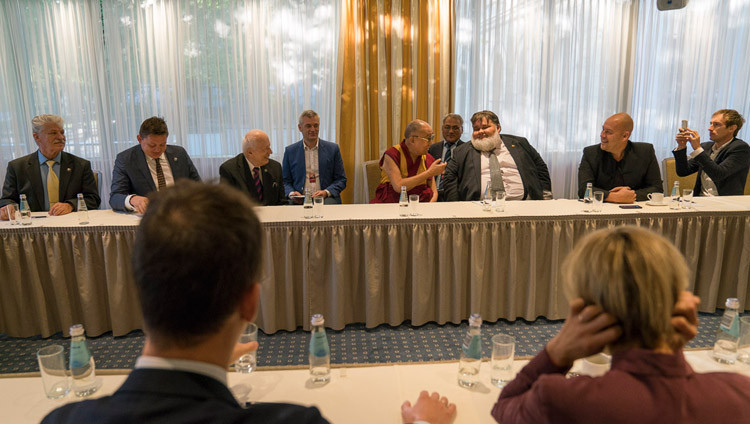
His Holiness was asked how these Parliamentarians could help Tibet and he told them that whenever they have the opportunity they can express their concern for Tibet. When they are told that all is well there, they should ask to go and see for themselves the situation of Tibetan language, education and culture, as well as the state of Tibet’s ecology.
His Holiness remarked that in 1959 Tibetans knew little about the world beyond India and the world knew little about Tibet. Since then knowledge and interest have grown. Chinese scholars have also reappraised the situation reporting that in historical records from the T’ang to the Manchu dynasties there is no reference to Tibet’s being a part of China. Claims to the contrary are evidence of the way totalitarian systems try to rewrite history. Now, many of China’s 400 million Buddhists are also coming to realize that Tibetan Buddhism is an authentic and authoritative tradition.
Characterising the Chinese-Tibet issue as a struggle between force and truth, His Holiness conceded that the power of weapons seems vigorous in the short term, but the power of truth will always be stronger in the long run. He thanked the various parliamentarians and assured them that their support is essential.
In the main hall, the second day of teachings opened once more with the ‘Heart Sutra’ being recited in Russian. His Holiness’s advice simultaneously translated into English, Russian, Latvian, Estonian and Mongolian is being broadcast to the audience over FM radio, while at the same time being webcast to the wider world.
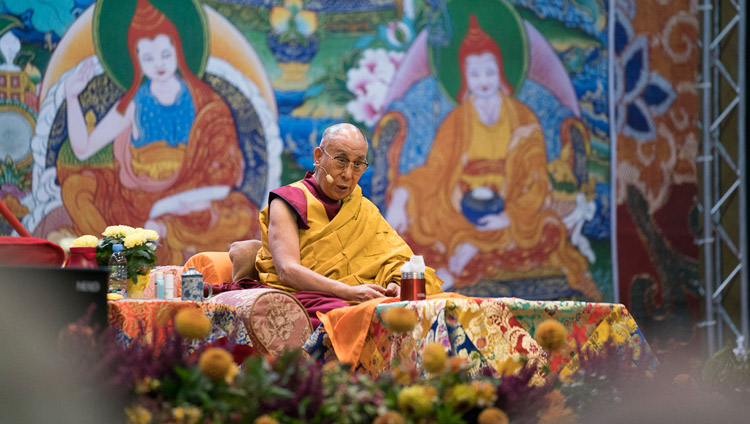
“All 7 billion of us on this planet want happiness, not suffering. In this all beings who experience pain and pleasure are the same,” His Holiness advised the audience. “Happiness and suffering both have physical and mental aspects. The physical aspect is related to sensory experience, while the mental aspect concerns consciousness. Ancient Indian traditions focus on practice involving mental consciousness and tackling negative emotions. According to the Sanskrit tradition of Buddhism, the aim is enlightenment on the basis of overcoming the twofold obscurations.
“The essence of Buddhahood, the emptiness of the mind, is obscured by obscurations and their imprints. All these obscurations can be eliminated by meditating on the emptiness of the mind—its natural purity and clear light nature. It is because of this clarity and awareness of the mind that we have the potential to manifest the four bodies of a Buddha—the nature and wisdom bodies of the truth body, as well as the enjoyment and emanation bodies.
“The accumulation of merit as a result of skilful means gives rise to the form body, while the accumulation of wisdom results in the truth body. Nagarjuna says the teaching of the Buddha depends on the Two Truths, conventional and ultimate, which is accepted by all four schools of Buddhist thought, even if their interpretations differ. The main factor in the accumulation of merit is the cultivation of the awakening mind of bodhichitta—and its expression in the service and benefit of others.”
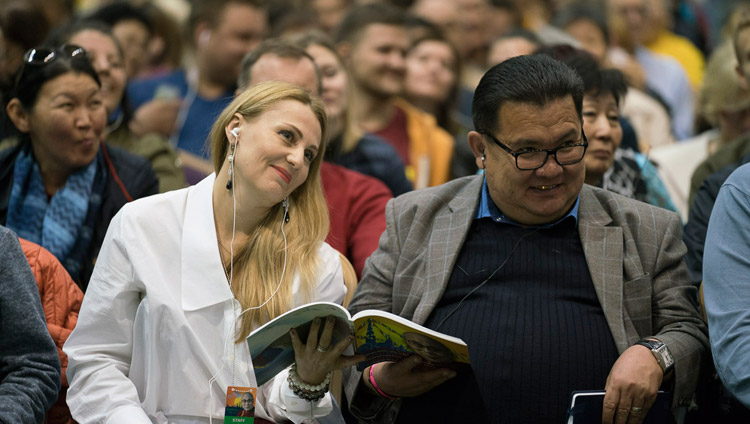
His Holiness then set the scene for conducting the ceremony for developing bodhichitta. He explained the potentially elaborate visualization of figures around the Buddha who have contributed to the transmission of Buddhism. He mentioned the eight bodhisattvas, the 17 Masters of Nalanda, the 84 great adepts, as well as the masters of the various traditions of Tibetan Buddhism.
He remarked that all the Nalanda Masters, except Nagarjuna, who is depicted being sheltered by serpents’ hoods, were portrayed in the painting behind him wearing hats. However, he suggested that there is no mention in the texts that they wore them. A hat is not included among the 13 possessions of a monk. On the other hand, accounts survive of Shantarakshita’s fashioning an upper garment out of the cover of his cushion because he was cold. This evolved into the shirt Tibetan monks wear today.
After conducting the bodhichitta ceremony, His Holiness resumed reading the ‘Stages of Meditation’, rapidly covering the sections on Wisdom, the Common Prerequisites for Meditating on Calm-abiding and Special Insight, the Practice of Calm-abiding, Actualizing Special Insight and Unifying Method and Wisdom. In the course of his reading, he stopped to explain, demonstrate and lead people through the nine-round breathing practice, which is employed for clearing and settling the mind in readiness for meditation.
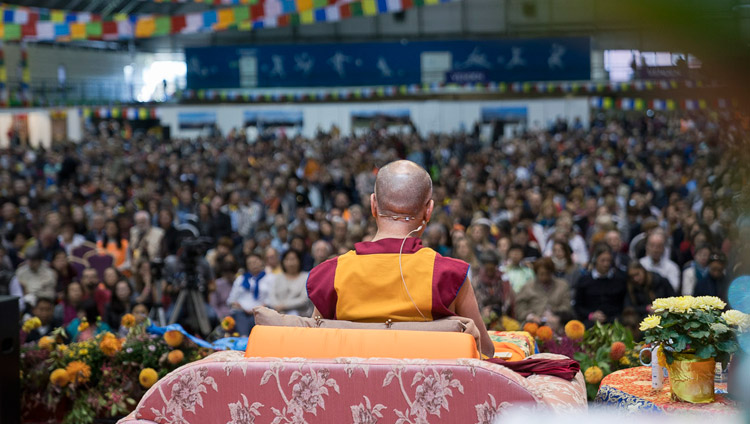
Once he had completed reading the ‘Stages of Meditation’ His Holiness read through the remaining verses of the ‘Concise Stages of the Path’, many of them related to the practice of the six perfections. He announced that he will teach Dza Patrul Rinpoche’s Dzogchen text ‘Three Keys Penetrating the Core’ tomorrow morning and will give a public talk in the afternoon.
Before leaving the Skonto Hall he met briefly with more than 40 Tibet supporters from the Baltic States. “I’m touched by your strong feelings for Tibet and towards me personally,” he told them. “Tibetan culture originally derived from the traditions of Nalanda University, which contains knowledge about the workings of the mind and emotions that is relevant today.
“Some short-sighted hardliners among Chinese officials regard anything that is unique to Tibet as somehow indicative of a move towards separation from China. Since we are not seeking independence they ought to be able to regard Tibet’s special qualities as part of the culture of the People’s Republic of China. In this context, the fact that supporters like all of you from time to time express concern about the condition of our language, culture and natural environment is useful and helpful. Thank you.”
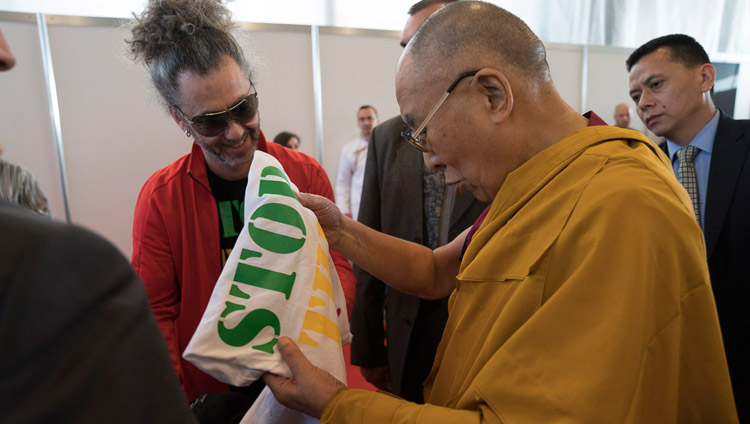
As His Holiness was leaving, Latvian singer Horens Stalbe stepped forward and offered him a couple of t-shirts advertising his song – Stop the War. Pleased with the slogan, His Holiness posed for a photograph with him, holding one of them in front of him.
Source: https://www.dalailama.com/news/2017/meeting-with-baltic-states-parliamentarians-continuation-of-teachings

